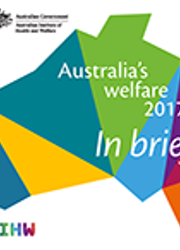Children, youth and families
How a family functions, and its socio-demographic characteristics, can play a critical role in the health and wellbeing of all its members. For children and youth, their family relationships and interactions—along with how they perform at school, their social interactions, and whether they are safe from harm—are among a multitude of factors that can have lifelong effects.
The majority of Australia's 9.4 million households are family households. In 2017 it is estimated that:
- 71% (6.7 million) are family households
- 25% (2.3 million) are single-person households
- 4% (403,000) are group households
In 2016, the majority of families were couple families (84%) and, of these, 44% had dependants living with them. Of the nearly 949,000 single-parent families, 65% had dependants living with them.
In 2017 there are 4.7 million children aged 0-14 in Australia, and a further 3.2 million young people aged 15-24.
More young children in formal care; fewer cared for by relatives
In 2014, nearly half (48%, or 1.8 million) of children aged 0-12 attended formal care (for example, long day care, or before- or after-school care) or informal care (for example, care provided by relatives or babysitters).
Since 1999, more children attend formal care, and fewer are being cared for by relatives. For example, between 1999 and 2014, the proportion of children aged 0-4 who:
- attended formal child care grew, from 27% to 37%
- received informal care fell, from 43% to 30%.
The proportion of children aged 0-4 attending long day care has almost doubled since 1999, rising from 18% in 1999 to 31% in 2014.
Grandparents are the most common source of informal child care; 23% of children aged 0-4 were cared for by their grandparents in 2014.
Children aged 0–4 in formal and informal care, 1999, 2002, 2005, 2008, 2011 and 2014
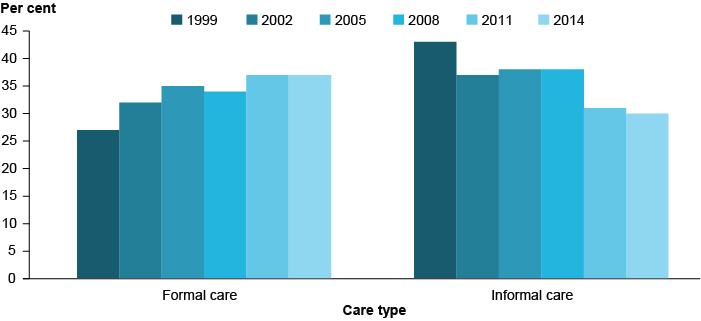
Find out more: Chapter 2.1 'Children in child care and preschool programs' in Australia's welfare 2017.
1 in 5 children developmentally vulnerable
On starting primary school, about 4 in 5 children are considered to be 'on track' developmentally, with about 1 in 5 (22%) developmentally vulnerable on one or more of five specific areas (domains).
Children were more likely to be developmentally vulnerable if they lived in Very remote or low socioeconomic areas.
The five domains
On starting school, a child’s development is assessed in five domains:
- physical health and wellbeing
- social competence
- emotional maturity
- language and cognitive skills
- communication skills and general knowledge.
Proportion of children assessed as developmentally vulnerable on one or more domains, by selected population groups, 2015
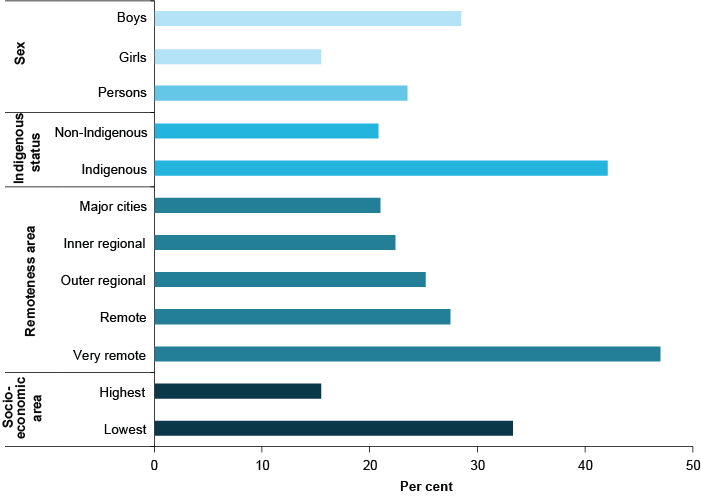
Find out more: Chapter 2.2 ‘Transition to primary school’ in Australia’s welfare 2017.
31,000 children in long-term out-of-home care
In 2015-16, more than 162,000 Australian children aged 0-17 received child protection services.
Out-of-home care is one of the main services offered under Australia's child protection system. More than 55,600 children had an out-of-home care placement in 2015-16—an increase of 11% (5,300 children) from 2012-13.
Almost 31,000 children had been in out-of-home care for 2 years or more because they were unable to live safely with their parents. Of these:
- most (70%) were aged between 5 and 14, with a median age of 10
- more than one-third (36%) were Aboriginal and Torres Strait Islander children
- 94% were living in home-based out-of-home care, including 43% with relatives/kin
- almost three-quarters (74%) had experienced more than one placement in their most recent episode of care.
For some children unable to return home, adoption can provide long-term care. Seventy children were adopted from out-of-home care in 2015-16 (25% of the 278 adoptions that year).
Find out more: Chapter 2.3 'Adoptions', Chapter 2.4 'Child protection' and Chapter 2.5 'A stable and secure home for children in out-of-home care' in Australia's welfare 2017.
Fewer young people under youth justice supervision
In 2015-16:
- 5,482 young people (aged 10 and older) were under supervision on an average day
- most young people under supervision were supervised in the community (84%)
- young people who were supervised by a youth justice agency spent 182 days or about 6 months, on average, under supervision.
Between 2011-12 and 2015-16, the number of young people aged 10 and older who were under supervision on an average day fell by 21% (from 6,959 to 5,482). As a rate, this was a decline from 27 to 21 per 10,000 people aged 10-17.
Rate of young people aged 10–17 under youth justice supervision on an average day, by supervision type, 2011–12 to 2015–16
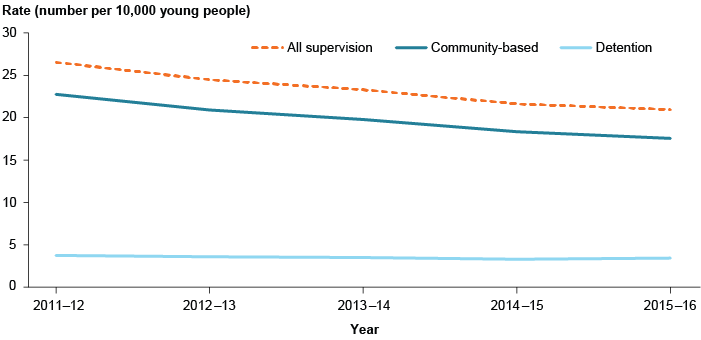
Most young people who receive a supervised youth justice sentence serve only one sentence, and do not return; 61% of young people under sentenced youth justice supervision from 2000-01 to 2015-16 and born between 1990-91 and 1997-98 received only one supervised sentence before the age of 18.
Find out more: Chapter 2.6 'Youth justice' in Australia's welfare 2017.
1 in 6 women victims of domestic violence
Family, domestic and sexual violence is a major public health and welfare issue in Australia and globally. The cost of violence against women and their children in Australia was estimated at $22 billion in 2015-16.
- One in 6 (17%) Australian women have experienced physical or sexual violence from a current or former cohabiting partner since the age of 15. This compares with around 1 in 19 (5.3%) men.
- In three-fifths (59%) of hospitalisations of females for assault in 2013-14, the perpetrator was a spouse or domestic partner (where the perpetrator was specified).
- Women were the victims in 75% of all intimate partner homicides that occurred between 2002-03 and 2011-12.
For female victims of physical violence (an estimated 1.2 million women, or 13% of all women), the most common perpetrator was a previous partner; for victims of sexual violence (estimated to be more than half a million women, or 6% of all women), it was most commonly a boyfriend/girlfriend or a date.
Women who have experienced violence since the age of 15, by type of violence and relationship to the perpetrator, 2012
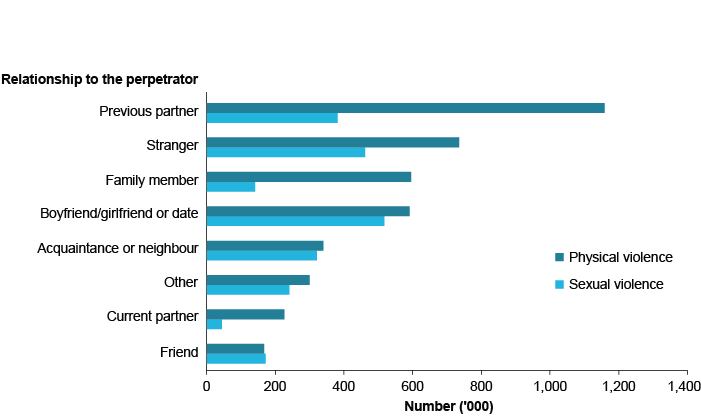
Find out more: Chapter 2.7 'Family, domestic and sexual violence' in Australia's welfare 2017.



